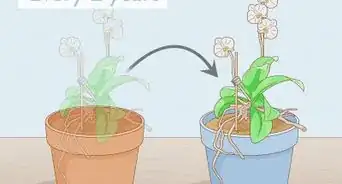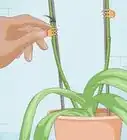This article was co-authored by Rachel Guffey and by wikiHow staff writer, Sophia Latorre. Rachel Guffey is a Plant Specialist and the Owner of Jungle House, a house plant shop based in Lawrence, Kansas. She specializes in plant education and caring for indoor plants. Rachel is passionate about using plants to help combat seasonal depression. She aims to make plants feel more accessible and approachable to everyone. Rachel has owned over 500 plants at one time.
There are 9 references cited in this article, which can be found at the bottom of the page.
wikiHow marks an article as reader-approved once it receives enough positive feedback. This article received 13 testimonials and 90% of readers who voted found it helpful, earning it our reader-approved status.
This article has been viewed 1,188,967 times.
Orchids are beautiful flowers that bloom in cycles. Just because the flowers have fallen off doesn’t mean that the orchid is dead—it’s simply in a dormant phase and will likely flower again. You can encourage blooming by pruning and repotting an orchid. Be sure to provide the right amount of water and light, as well. Before you know it, gorgeous flowers will appear!
Steps
Encouraging an Orchid to Bloom
-
1Cut back the stalk when the flowers fall off. Use a sharp, sterilized pair of pruning shears or a razor to trim the stalk when the plant has stopped blooming. Leave about 1 inch (2.5 cm) of the stalk, or spike, so that it can regrow.[1]
Tip: Cut the stalk 1⁄4 inch (0.64 cm) above a node (or bump) on the stem to encourage the orchid to flower again more quickly.
-
2Move the orchid to a new pot once the roots start poking out of the bottom. Water the orchid, then gently tug the plant out of its pot. Use your hands to loosen the roots a bit and dust off any growing media stuck to them. Then, carefully place the orchid into the new pot.[2]
- If possible, pick a pot designed for orchids. If you can’t find one, opt for a pot with lots of drainage holes to allow air to flow in and water to drain out. Put a saucer underneath the pot to catch excess water.
- If the roots of your orchid begin growing out through the holes in the bottom of the pot, that’s an indication that the pot is too small and you should move it to a larger one.
Tip: Choose a pot that’s just large enough for the roots of the orchid to fit in. You want them to be snug in the pot so they are held together, but don’t pick a pot that’s so small that you have to stuff the roots into it.[3]
Advertisement -
3Add fresh growing medium to give your orchid a nutrient boost. To promote the reblooming of orchids, mix 2 parts bark formulated specifically for orchids with 1 part peat moss to create the growing medium. Fill the space around the roots with the medium and add a light layer on top, but be sure you don’t cover the leaves.[4]
Providing the Ideal Growing Conditions
-
1Water less often if you notice mushy roots. Most orchid issues are caused by overwatering. Your orchid might be getting too much water if it has soggy roots or rotting, limp, or discolored leaves. Just decrease how much, and how frequently, you water your orchid to get it to look its best.[8]
- If the roots are rotted, trim off the worst of the damage and repot the plant to provide it with additional nutrients.
- Be sure to dump out any water that collects in the saucer underneath the pot after you water.
- Orchids prefer to be flushed out than to sit in a pool of standing water. To do this, simply take your plant to a sink and flush out the pot with water, rinsing the roots for a few seconds. Just try not to get any water in the crooks of the green leaves when you do this![9]
-
2Increase how much you’re watering if the roots are dry and shriveled. Alternatively, some orchids don’t get enough water and fail to thrive as a result. If the roots look dry and shriveled instead of lush and plump, your plant is dehydrated. Another sign of underwatering is shriveled or discolored leaves. Water your orchid more frequently to correct this problem.[10]
- Use room-temperature water to water your orchid. Rainwater is ideal, but tap water that has sat out for 24 hours will also work, as this gives the chlorine time to evaporate.
Tip: Spritz the roots and foliage with water each day to provide a humid environment for your orchid.[11]
-
3Provide more light if the leaves are dark green. Orchids thrive in sunny environments. If yours has very dark green leaves, it might not be getting enough sunlight. Try moving it in front of a window or into a sunnier outdoor spot.[12]
- If your orchid is outside, leaves or other foliage from surrounding plants or trees might be providing too much shade.
-
4Reduce the amount of light your orchid gets if it’s sunburned. Orchids that receive too much light may first show yellow leaves. As time goes on, the leaves will turn white, then brown. Additionally, if the leaves feel hot to the touch, it’s getting too much sun. If you notice these symptoms, move your orchid to an area with less direct sunlight.[13]
- You can move the plant further away from a window or provide more shade by situating it near taller plants or trees.
-
5Raise the temperature if your orchid is discolored or has pitting or lesions. Keeping your orchid at the wrong temperature can cause all sorts of problems. If your orchid is in a spot with temperatures below 50 °F (10 °C), it’s likely not thriving. Try moving your orchid to a warmer location if your orchid is discolored or has pits, lesions, or sunken areas.[14]
Tip: If your orchid is planted outside, layer mulch around the base of the plant to insulate it. Then, cover it with a frost cloth or piece of burlap to protect the foliage from the cold.
-
6Move your orchid to a cooler spot if it has wilted, leathery, or yellowing leaves. Just as a too-cold environment can impact your orchid, so can one that’s too hot. Move your orchid to a cooler location or provide some shade for it if the temperature is above 80 °F (27 °C). Signs of heat stress include yellowing, withered, or leathery leaves or brown roots or leaf tips.[15]
Expert Q&A
-
QuestionHow do you care for orchids?
 Monique CapanelliMonique Capanelli is a Plant Specialist and the Owner and Designer for Articulture Designs, an innovative design firm and boutique in Austin, Texas. With over 15 years of experience, Monique specializes in interior botanical design, living walls, event decor, and sustainable landscape design. She attended the University of Texas at Austin. Monique is a Certified Permaculture Designer. She provides plant and botanical design experiences, from small gifts to entire transformations, to shoppers as well as commercial clients including Whole Foods Market and The Four Seasons.
Monique CapanelliMonique Capanelli is a Plant Specialist and the Owner and Designer for Articulture Designs, an innovative design firm and boutique in Austin, Texas. With over 15 years of experience, Monique specializes in interior botanical design, living walls, event decor, and sustainable landscape design. She attended the University of Texas at Austin. Monique is a Certified Permaculture Designer. She provides plant and botanical design experiences, from small gifts to entire transformations, to shoppers as well as commercial clients including Whole Foods Market and The Four Seasons.
Plant Specialist
-
QuestionI have a plant with no leaves and no roots can it still be saved?
 wikiHow Staff EditorThis answer was written by one of our trained team of researchers who validated it for accuracy and comprehensiveness.
wikiHow Staff EditorThis answer was written by one of our trained team of researchers who validated it for accuracy and comprehensiveness.
Staff Answer wikiHow Staff EditorStaff AnswerUnfortunately not. If the roots are damaged, the plant will most likely die.
wikiHow Staff EditorStaff AnswerUnfortunately not. If the roots are damaged, the plant will most likely die. -
QuestionShould "air roots" be put into the planting soil when being transplanted, or trimmed off?
 Community AnswerNo, don't cut them off. When you transplant your orchid, try to replicate how the plant looked in the old container. Make sure all the air roots are out of the soil. Apparently the plant takes in some nutrients from the air as well as the soil. I use an orchid liquid fertilizer once a month (diluted in water, instructions are on the bottle). They also don't need that much soil/orchid compost. The main thing to do, though, is not over water them. Mine are happy when I have plunged them into sink full of water, flower pot and all, when they get dry.
Community AnswerNo, don't cut them off. When you transplant your orchid, try to replicate how the plant looked in the old container. Make sure all the air roots are out of the soil. Apparently the plant takes in some nutrients from the air as well as the soil. I use an orchid liquid fertilizer once a month (diluted in water, instructions are on the bottle). They also don't need that much soil/orchid compost. The main thing to do, though, is not over water them. Mine are happy when I have plunged them into sink full of water, flower pot and all, when they get dry.
References
- ↑ https://www.rhs.org.uk/plants/articles/graham-rice/house-or-conservatory-plants/keeping-indoor-orchids-flowering
- ↑ https://www.bhg.com/gardening/houseplants/care/how-do-i-repot-my-orchid/
- ↑ http://www.orchidcarezone.com/can-i-save-my-dying-orchid/
- ↑ https://www.bhg.com/gardening/houseplants/care/how-do-i-repot-my-orchid/
- ↑ Rachel Guffey. Plant Specialist. Expert Interview. 5 August 2021.
- ↑ https://www.bhg.com/gardening/houseplants/care/how-do-i-repot-my-orchid/
- ↑ Rachel Guffey. Plant Specialist. Expert Interview. 5 August 2021.
- ↑ https://www.gardenandgreenhouse.net/articles/july-august-2015/focus-on-orchids-how-to-tell-if-you-are-over-watering-or-under-watering-your-orchids/
- ↑ Rachel Guffey. Plant Specialist. Expert Interview. 5 August 2021.
- ↑ https://www.gardenandgreenhouse.net/articles/july-august-2015/focus-on-orchids-how-to-tell-if-you-are-over-watering-or-under-watering-your-orchids/
- ↑ https://www.rhs.org.uk/advice/profile?pid=333
- ↑ http://www.aos.org/orchids/additional-resources/light-the-key-to-successful-blooming.aspx
- ↑ http://www.aos.org/orchids/additional-resources/light-the-key-to-successful-blooming.aspx
- ↑ http://www.aos.org/orchids/orchid-pests-diseases/cold-damage.aspx
- ↑ http://www.aos.org/orchids/orchid-pests-diseases/heat-stress.aspx
About This Article
You can revive an orchid plant by repotting it in some fresh growing medium. First, cut back any dead stalks, leaving about 1 inch (2.5 cm). Then, water the orchid lightly, and lift it out of its current pot. Replant the orchid in a new pot with fresh growing medium to give it a nutrient boost. Use 2 parts orchid bark mixed with 1 part peat moss. Avoid regular potting soil since it's too dense for orchid roots. If your orchid’s roots were dry and shriveled when you repotted it, that means it’s not getting enough water. If the roots were mushy, that means it’s getting too much water. Try to water your orchid once a week in the winter and twice a week in the spring, summer, and fall. Place your orchid in a spot that gets lots of indirect sunlight so it thrives. To learn how to create the best growing conditions for your orchid, read on!
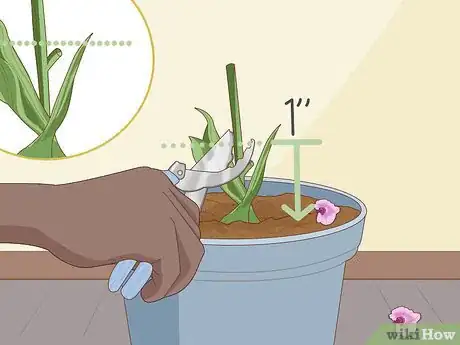
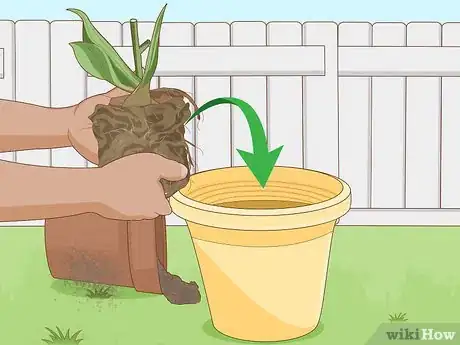
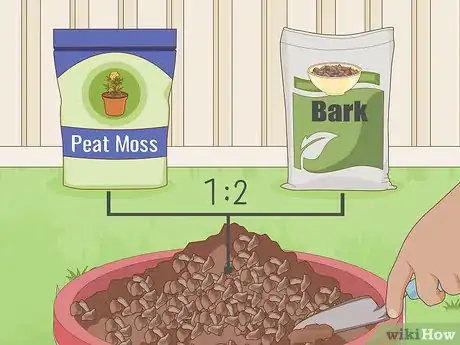

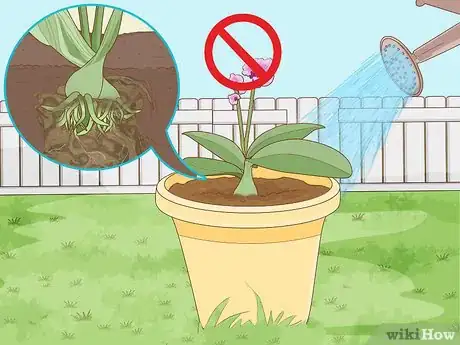
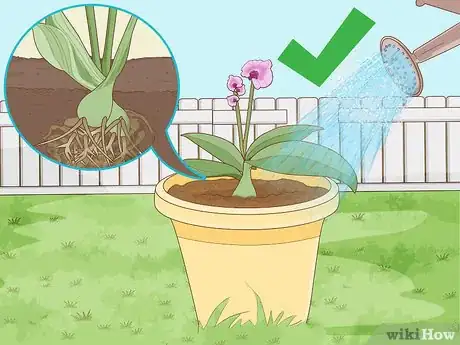
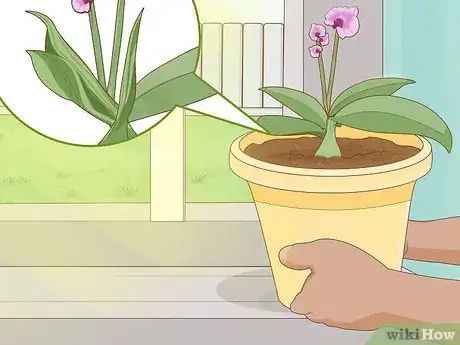
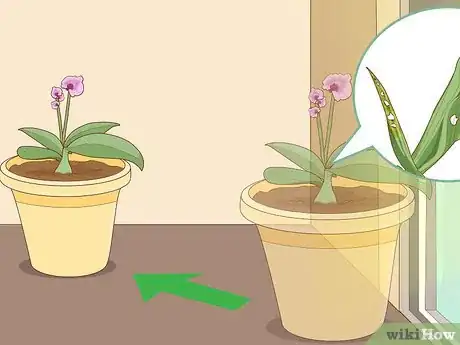
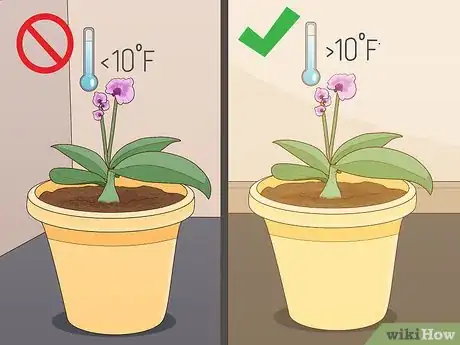
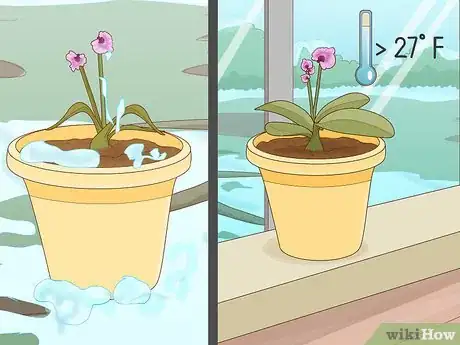
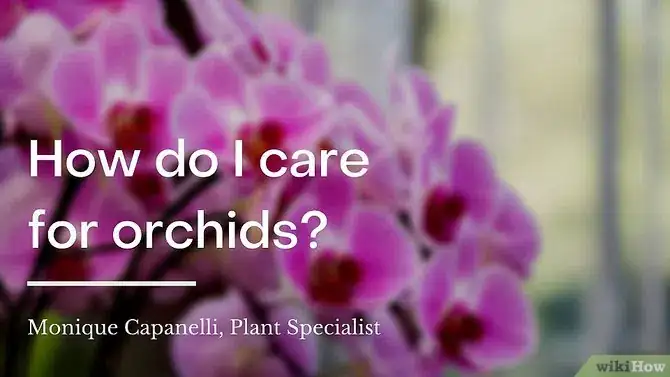
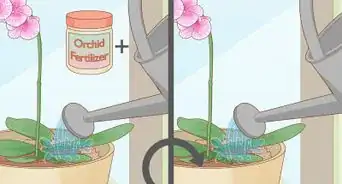

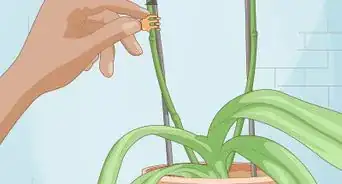
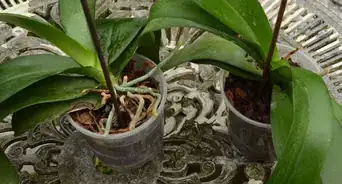

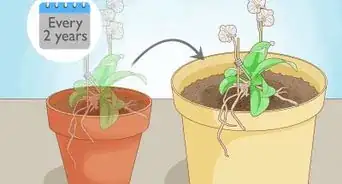



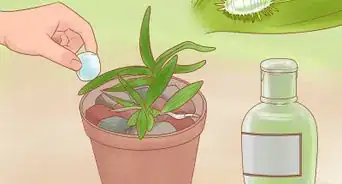

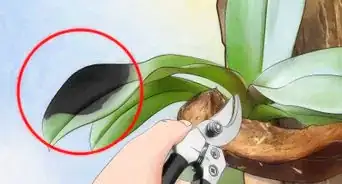
-Step-8.webp)
